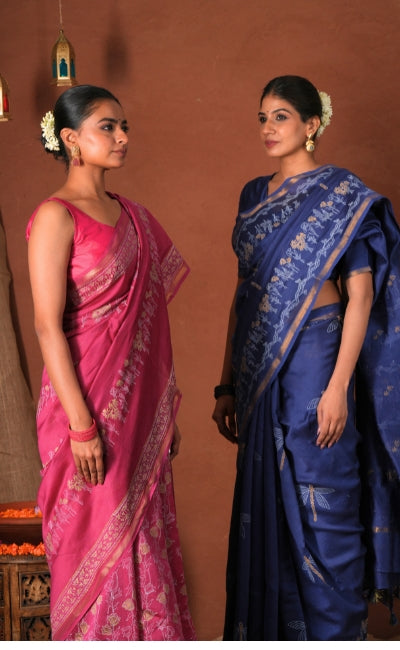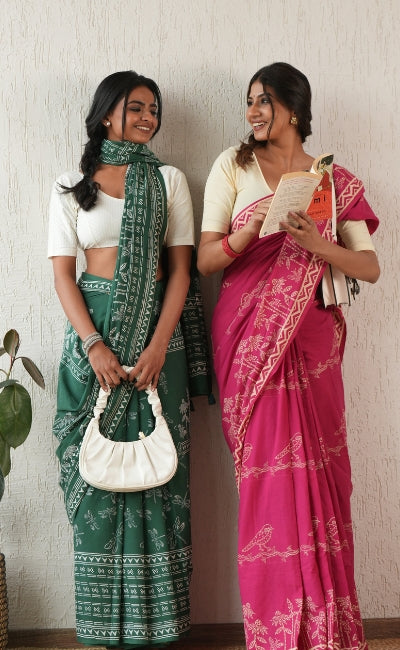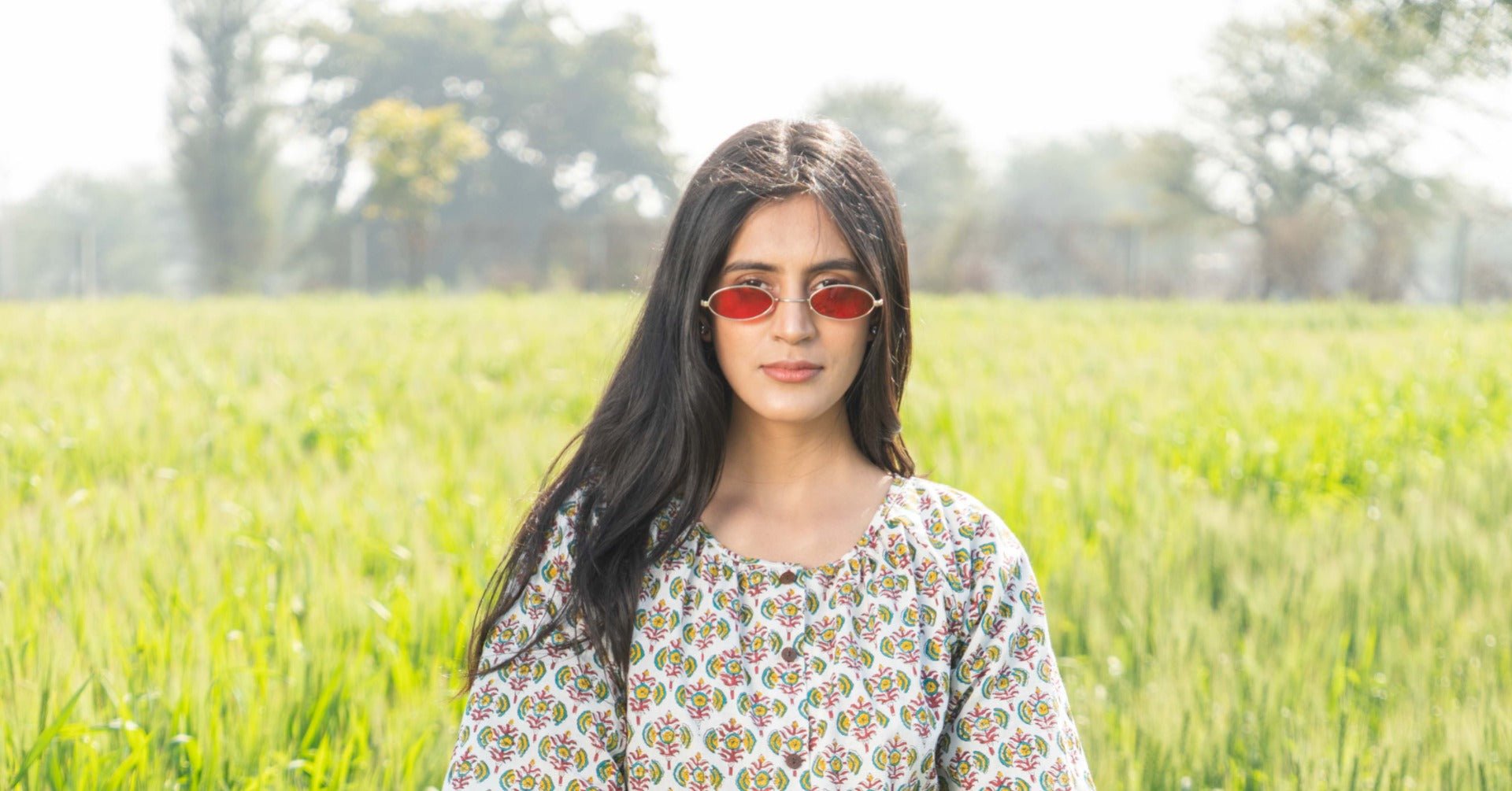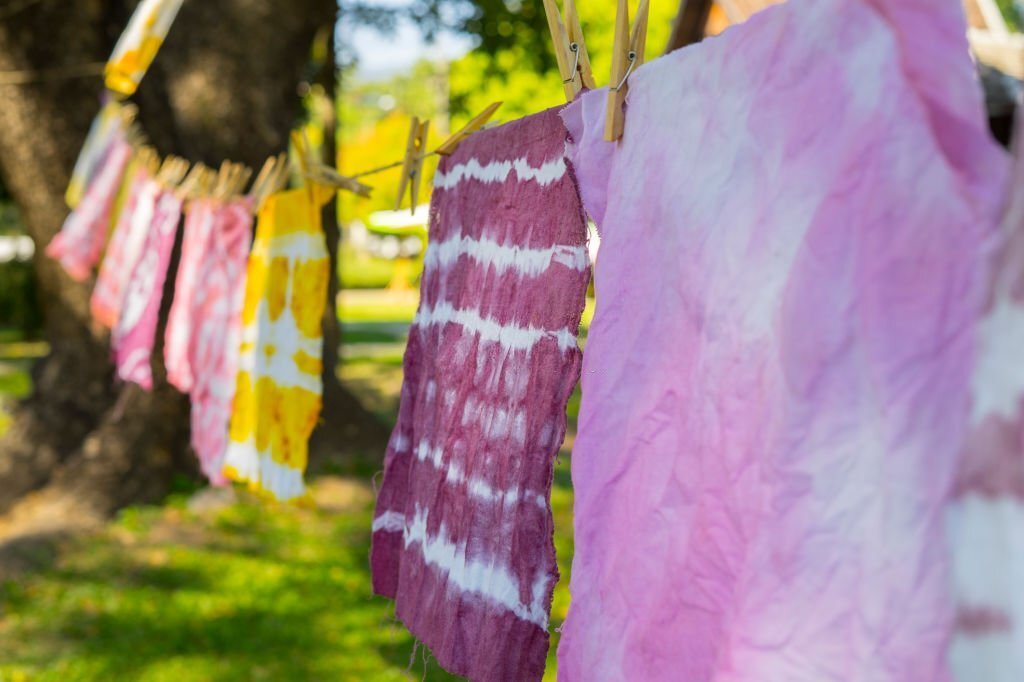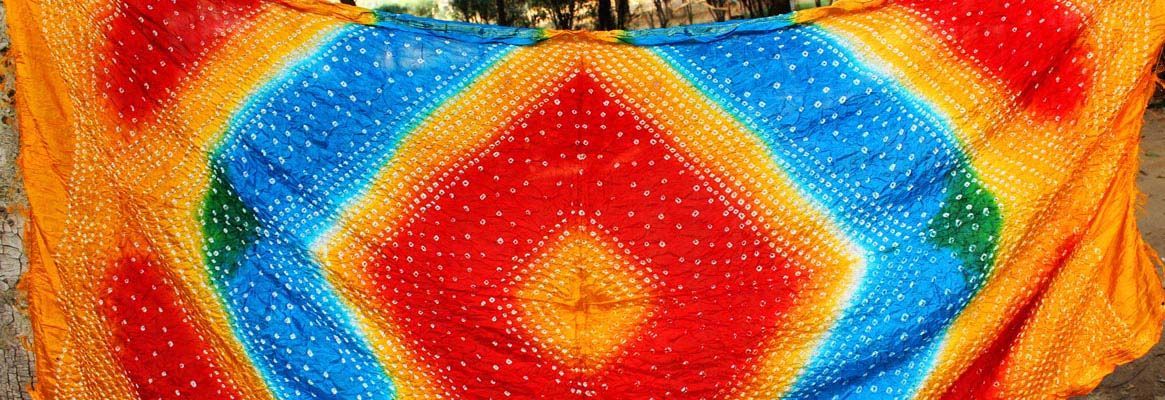
All about SootiSyahi's Hand Block Printed Bandhani Dupatta
Bandhani, also known as Bandhej, is a sort of tie-dye textile that is embellished by plucking the cloth into a pattern of bindings. Sootisyahi believes that creating or building art is a true form, and has a wide range of Bandhani dupatta. But creating art on the fabric is beyond the next level of creativity that their artisans and designers are experts in.
Who doesn't love the poetry crafted on the amazing bandhani silk? But, who's there to fulfill that demand of old-fashioned yet the most iconic and authentic poetry art form over the fabric?
Sootisyahi is the place to consider; why? Because Sootisyahi is one of the best hand-block printing fashion brands in India. Every search of your hand-crafted products ends here. We are here to provide you with the best crafts designed by our professional artisans with the authenticity initiated centuries ago.
But what exactly is Bandhani?
Bandhani is a very common word derived from the Sanskrit word 'Banda,' which means 'to tie.' TIE and DYE, that's what we expertise in, and that's what we offer to the customers worldwide.
Bandhani is most commonly done on fabrics like cotton and silk. Our artisans use the fabric that is firmly knotted before being put in a dye bath. Then the knotted portion is dyed in brilliant colors to give you the best pattern of your dreams.
Bandhej, we must not be aware of but is made up of different designs, gorgeous color patterns/combinations, and enticing twirls.
Bandhani is a beautiful ancient art technique of dying a fabric carried out by our ancestors, where we can use a thread in multiple ways to create a variety of patterns. Many people believe that the “Muslim Khatris of Kutch” were among the first to employ this kind of dyeing.
This type of art is mainly practiced in Rajasthan, Gujarat, and parts of Uttar Pradesh.
The oldest type of tie and dye is Bandhej, commonly referred to as Bandhani. Sootisyahi has Shibori Bandhani Dupatta in Silk and Saree's hand-crafted with love for you.
According to historical texts, royal women were the first to wear Bandhani saree at weddings centuries ago. You can find the visual portrayal of Bandhej in the Ajanta caves, and this old art form is still practiced today.
What is the reason that the art form is still in practice? Well, the answer is pretty straightforward because it is pure love displayed and carried out in the form of poetry to all the art lovers around, giving the authentic royal look.
Bandhani's primary market is in Gujarat. However, Bandhej is also sold throughout India due to increased demand. Rajasthani cities like Jaipur, Sikar, Bhilwara, Udaipur, Bikaner, Ajmer, and Jamnagar are well-known for their odhni sarees and turbans.
The Bandhani fabric isn't just limited to women but also a part of the male community. For centuries, different Rajasthani community people have been wearing turbans with multiple bandhani patterns on their heads designed by the artisans. At that time, the design or the variety of the pattern was a symbol of a person's community status.
Even today, in many different communities, wearing Bandhani is a sign of belonging. People usually prefer Bandhej at weddings and other ceremonial ceremonies. The more intricate the Bandhani work, the more pricey the fabric. Sootisyahi makes sure that you don't have to compromise on the look and the feel of the fabric you are wearing.
Natural hues dominate bandhani, with the most common colors like pink, blue, green, and black. We have a vast range of these natural hue patterns. Just take a look, and we are sure you will fall in love with the design, pattern, and color combination.
Gujarat and Rajasthan are two known places for their Bandhani dupatta and sarees. Bandhani saree patterns have been on the trending fashion list lately. Women even prefer wearing these increasingly fashionable clothing for almost any occasion. Bandhej, also known as Bandhani, is a lovely art form, loved and enjoyed by both the genders of the community.
To get the best-refined look, Sootisyahi suggests you not iron bandhani products on high heat, as it will lose its strength. So it's highly recommended to dry clean it or iron it on a low heat setting.
"Many people associate tie-dye with the hippie movement in the United States throughout the 1960s and 1970s. On the other hand, tie-dyeing has a long history dating back to prehistoric times. Alexander the Great recounts the magnificent colors he experienced in India in his books; therefore, tie-dye may be traced back to the 300s BC."
Different tying and dyeing procedures have been employed for ages in India, Japan, and Africa, using both natural and artificial ingredients to create both plain and patterned items.
But, Sootisyahi offers only authentic artwork in the form of sarees and bandhani dupatta that was practiced centuries ago, keeping in mind the taste of that royal look.
For various reasons, dyes have had a significant meaning in India. Centuries ago, Indian brides traditionally wore these "Bandhani" sarees as a sign of good luck. This ritual is still carried out and is being performed today in many parts of Gujarat.
Bandhani methods have been passed down as art from generation to generation. And Sootisyahi has been keeping the real art alive for years and will keep it alive for centuries to come.
Depending on the dyeing criteria, our designers create the art precisely. Initially, the artisans used natural components like flowers, roots, leaves, bark, and berries to manufacture dyes. But, today, we can see both natural and man-made products being used to create lively art.
Steps Sootisyahi Involves Along With The Resulting Patterns
Our artisans first softly sketch the area of the fabric that is to be dyed in the desired color. Then, they apply a thin piece of translucent plastic on top of that. This plastic has pin-sized holes through which the chosen color and pattern are transferred onto the fabric.
With this technique, the dyer then pulls a little bit of fabric through an area with an imprint of the hole, twisting thread around the cloth and coming through the hole to produce a small knot. After knots have been knotted, the fabric is washed to remove any remaining imprints. The fabric is then soaked in a naphthol chemical for five minutes, followed by a light color dye for two minutes.
The fabric is rinsed, extra liquid squeezed out, dried, knotted, then dipped in a deeper color once more. The fabric/cloth is left to soak in the colors for three to four hours, enabling the fabric beneath the stitched knots to remain undyed.
The fabric is then washed and starched as needed once it is finished. Once the cloth has dried, the creators carefully rip it apart to reveal the distinctive pattern of blank spots behind the tied knots.
Our artisans create a beautiful, colorful fabric with intricate forms and decorations, such as flowers and bells, with this tie-and-dye process.
Prevalent Clusters With a Special Meaning
Each of the most prevalent clusters and knot designs formed from patterns has its unique name.
We will love to explain to you with proper meaning so that you can explore and learn a bit more about Bandhani.
- Ekdali means "single dot" in Sanskrit
- Chaubundi means four dots
- Tikunthi is often known with three dots that form circles and rectangles
- Satbandi is a pattern of seven dots
- Boond is a tiny dark dot in the center
- Kodi is a pattern in the shape of a tear or a drop
- Shikargah or Dungar Shah is a mountain-shaped pattern
- Jaaldar is a type of art form that resembles a web.
- Beldaar is similar to a vine
- The swirling pattern is identical to a Laddu Jalebi
- Leheriya is a pattern resembling a wave
Colors Used - Do They Mean Something?
We at Sootisyahi believe that the colors have a significant meaning, just like the patterns of Bandhani dyeing. Authentically and traditionally, only two colors are often used at a time. Mainly yellow and red, because they are considered lucky in Indian culture. Why? Because they were utilized when this form of tie-dye first appeared.
But nowadays, you can see various colors in varied tones like yellow, red, green, and pink used in the Bandhani art method.
No matter if the colors have changed in modern times, yet they have a particular meaning with a significant cultural significance. You can see a bride or freshly married woman wearing red, whereas a new mother can be seen wearing yellow.
Sootisyahi Suggestion Over Bandhani Products Look After
We have stated above that Bandhani products (bandhani saree/bandhani dupatta) should be dry cleaned and ironed on a low heat setting for the most remarkable results and longevity. But always remember that washing or ironing on high heat is strictly forbidden because it will destroy the clothing.
Bandhani Attires Demand In The Market
In terms of wearability, bandhani outfits are highly adaptable. These are considered perfect for casual get-togethers, formal, informal gatherings, or celebrations. Bandhani attire is, in fact, popular among females because of its ideal combination of style and comfort. Similarly, men can enjoy the Bandhani turbans for their daily wear (mainly in cities like Rajasthan and Gujarat) or on occasion (marriages or other ceremonies).
Want Your Tie-Dye?
While the ancient technique of Bandhani tie-dye is intricate, Tie-dye may also be an easy and enjoyable exercise for creating one-of-a-kind items.
Sootisyahi can design and create the art as you demand, but we have our own wide range of designs and patterns to satisfy your fashion needs. You can wear it as per your liking and try new and refined looks styling it in a "Diva" style.
All that is required are blank garments and any colored dyes. At www.sootisyahi.com, you can get some high-quality, budget-friendly items (as well as already tie-dyed bandhani dupatta and sarees).


